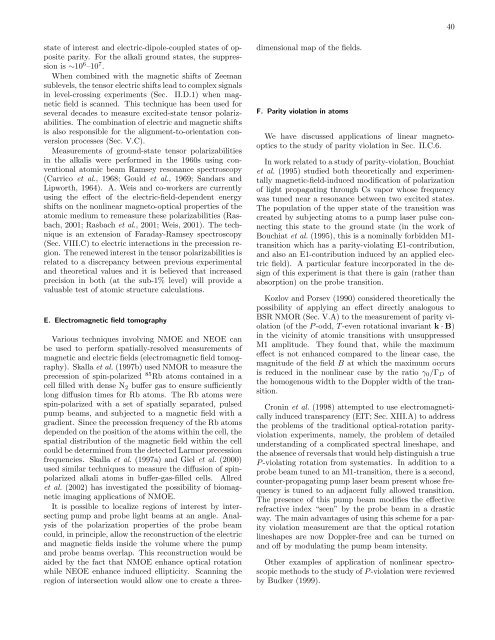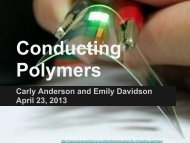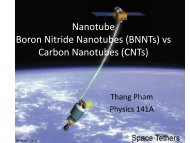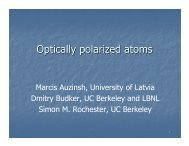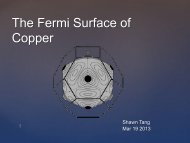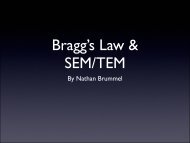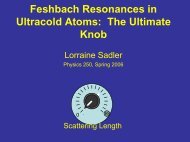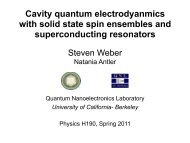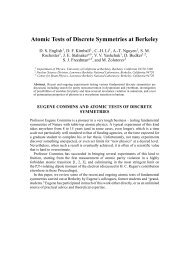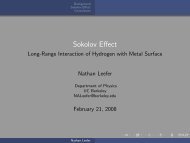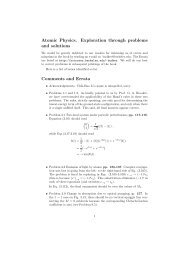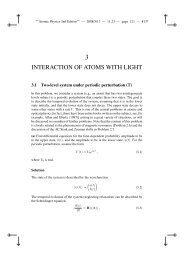Resonant nonlinear magneto-optical effects in atomsâ - The Budker ...
Resonant nonlinear magneto-optical effects in atomsâ - The Budker ...
Resonant nonlinear magneto-optical effects in atomsâ - The Budker ...
You also want an ePaper? Increase the reach of your titles
YUMPU automatically turns print PDFs into web optimized ePapers that Google loves.
40<br />
state of <strong>in</strong>terest and electric-dipole-coupled states of opposite<br />
parity. For the alkali ground states, the suppression<br />
is ∼10 6 –10 7 .<br />
When comb<strong>in</strong>ed with the magnetic shifts of Zeeman<br />
sublevels, the tensor electric shifts lead to complex signals<br />
<strong>in</strong> level-cross<strong>in</strong>g experiments (Sec. II.D.1) when magnetic<br />
field is scanned. This technique has been used for<br />
several decades to measure excited-state tensor polarizabilities.<br />
<strong>The</strong> comb<strong>in</strong>ation of electric and magnetic shifts<br />
is also responsible for the alignment-to-orientation conversion<br />
processes (Sec. V.C).<br />
Measurements of ground-state tensor polarizabilities<br />
<strong>in</strong> the alkalis were performed <strong>in</strong> the 1960s us<strong>in</strong>g conventional<br />
atomic beam Ramsey resonance spectroscopy<br />
(Carrico et al., 1968; Gould et al., 1969; Sandars and<br />
Lipworth, 1964). A. Weis and co-workers are currently<br />
us<strong>in</strong>g the effect of the electric-field-dependent energy<br />
shifts on the <strong>nonl<strong>in</strong>ear</strong> <strong>magneto</strong>-<strong>optical</strong> properties of the<br />
atomic medium to remeasure these polarizabilities (Rasbach,<br />
2001; Rasbach et al., 2001; Weis, 2001). <strong>The</strong> technique<br />
is an extension of Faraday-Ramsey spectroscopy<br />
(Sec. VIII.C) to electric <strong>in</strong>teractions <strong>in</strong> the precession region.<br />
<strong>The</strong> renewed <strong>in</strong>terest <strong>in</strong> the tensor polarizabilities is<br />
related to a discrepancy between previous experimental<br />
and theoretical values and it is believed that <strong>in</strong>creased<br />
precision <strong>in</strong> both (at the sub-1% level) will provide a<br />
valuable test of atomic structure calculations.<br />
E. Electromagnetic field tomography<br />
Various techniques <strong>in</strong>volv<strong>in</strong>g NMOE and NEOE can<br />
be used to perform spatially-resolved measurements of<br />
magnetic and electric fields (electromagnetic field tomography).<br />
Skalla et al. (1997b) used NMOR to measure the<br />
precession of sp<strong>in</strong>-polarized 85 Rb atoms conta<strong>in</strong>ed <strong>in</strong> a<br />
cell filled with dense N 2 buffer gas to ensure sufficiently<br />
long diffusion times for Rb atoms. <strong>The</strong> Rb atoms were<br />
sp<strong>in</strong>-polarized with a set of spatially separated, pulsed<br />
pump beams, and subjected to a magnetic field with a<br />
gradient. S<strong>in</strong>ce the precession frequency of the Rb atoms<br />
depended on the position of the atoms with<strong>in</strong> the cell, the<br />
spatial distribution of the magnetic field with<strong>in</strong> the cell<br />
could be determ<strong>in</strong>ed from the detected Larmor precession<br />
frequencies. Skalla et al. (1997a) and Giel et al. (2000)<br />
used similar techniques to measure the diffusion of sp<strong>in</strong>polarized<br />
alkali atoms <strong>in</strong> buffer-gas-filled cells. Allred<br />
et al. (2002) has <strong>in</strong>vestigated the possibility of biomagnetic<br />
imag<strong>in</strong>g applications of NMOE.<br />
It is possible to localize regions of <strong>in</strong>terest by <strong>in</strong>tersect<strong>in</strong>g<br />
pump and probe light beams at an angle. Analysis<br />
of the polarization properties of the probe beam<br />
could, <strong>in</strong> pr<strong>in</strong>ciple, allow the reconstruction of the electric<br />
and magnetic fields <strong>in</strong>side the volume where the pump<br />
and probe beams overlap. This reconstruction would be<br />
aided by the fact that NMOE enhance <strong>optical</strong> rotation<br />
while NEOE enhance <strong>in</strong>duced ellipticity. Scann<strong>in</strong>g the<br />
region of <strong>in</strong>tersection would allow one to create a threedimensional<br />
map of the fields.<br />
F. Parity violation <strong>in</strong> atoms<br />
We have discussed applications of l<strong>in</strong>ear <strong>magneto</strong>optics<br />
to the study of parity violation <strong>in</strong> Sec. II.C.6.<br />
In work related to a study of parity-violation, Bouchiat<br />
et al. (1995) studied both theoretically and experimentally<br />
magnetic-field-<strong>in</strong>duced modification of polarization<br />
of light propagat<strong>in</strong>g through Cs vapor whose frequency<br />
was tuned near a resonance between two excited states.<br />
<strong>The</strong> population of the upper state of the transition was<br />
created by subject<strong>in</strong>g atoms to a pump laser pulse connect<strong>in</strong>g<br />
this state to the ground state (<strong>in</strong> the work of<br />
Bouchiat et al. (1995), this is a nom<strong>in</strong>ally forbidden M1-<br />
transition which has a parity-violat<strong>in</strong>g E1-contribution,<br />
and also an E1-contribution <strong>in</strong>duced by an applied electric<br />
field). A particular feature <strong>in</strong>corporated <strong>in</strong> the design<br />
of this experiment is that there is ga<strong>in</strong> (rather than<br />
absorption) on the probe transition.<br />
Kozlov and Porsev (1990) considered theoretically the<br />
possibility of apply<strong>in</strong>g an effect directly analogous to<br />
BSR NMOR (Sec. V.A) to the measurement of parity violation<br />
(of the P -odd, T -even rotational <strong>in</strong>variant k · B)<br />
<strong>in</strong> the vic<strong>in</strong>ity of atomic transitions with unsuppressed<br />
M1 amplitude. <strong>The</strong>y found that, while the maximum<br />
effect is not enhanced compared to the l<strong>in</strong>ear case, the<br />
magnitude of the field B at which the maximum occurs<br />
is reduced <strong>in</strong> the <strong>nonl<strong>in</strong>ear</strong> case by the ratio γ 0 /Γ D of<br />
the homogenous width to the Doppler width of the transition.<br />
Cron<strong>in</strong> et al. (1998) attempted to use electromagnetically<br />
<strong>in</strong>duced transparency (EIT; Sec. XIII.A) to address<br />
the problems of the traditional <strong>optical</strong>-rotation parityviolation<br />
experiments, namely, the problem of detailed<br />
understand<strong>in</strong>g of a complicated spectral l<strong>in</strong>eshape, and<br />
the absence of reversals that would help dist<strong>in</strong>guish a true<br />
P -violat<strong>in</strong>g rotation from systematics. In addition to a<br />
probe beam tuned to an M1-transition, there is a second,<br />
counter-propagat<strong>in</strong>g pump laser beam present whose frequency<br />
is tuned to an adjacent fully allowed transition.<br />
<strong>The</strong> presence of this pump beam modifies the effective<br />
refractive <strong>in</strong>dex “seen” by the probe beam <strong>in</strong> a drastic<br />
way. <strong>The</strong> ma<strong>in</strong> advantages of us<strong>in</strong>g this scheme for a parity<br />
violation measurement are that the <strong>optical</strong> rotation<br />
l<strong>in</strong>eshapes are now Doppler-free and can be turned on<br />
and off by modulat<strong>in</strong>g the pump beam <strong>in</strong>tensity.<br />
Other examples of application of <strong>nonl<strong>in</strong>ear</strong> spectroscopic<br />
methods to the study of P -violation were reviewed<br />
by <strong>Budker</strong> (1999).


